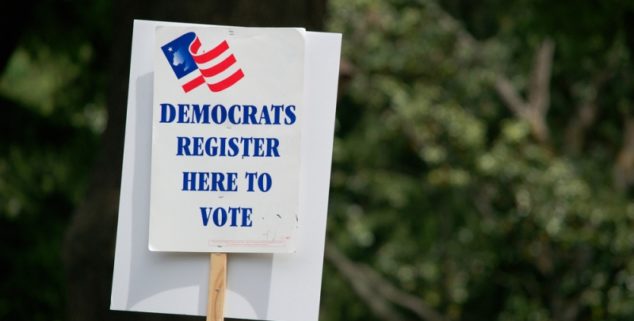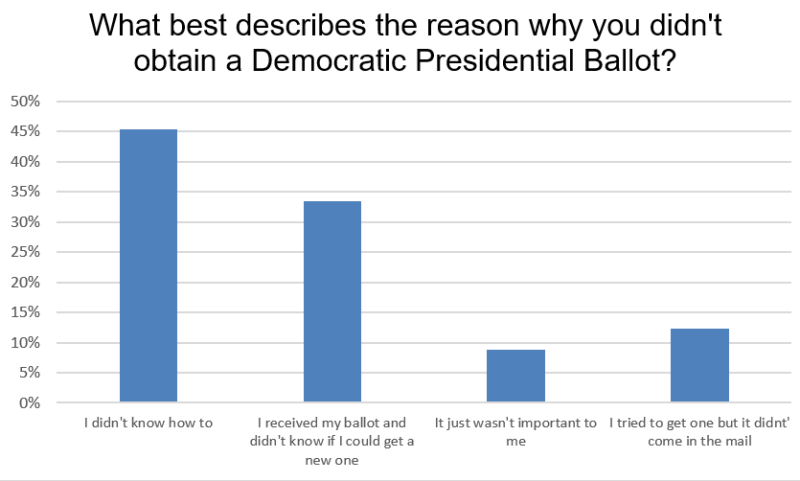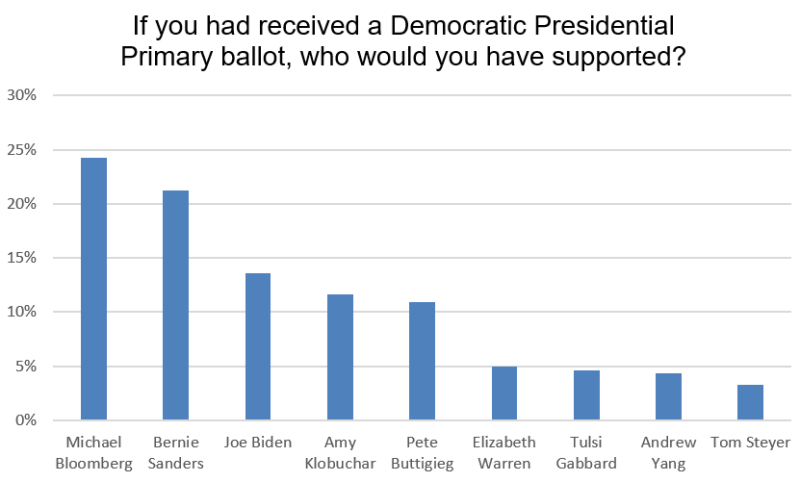News
CA120: Confusion for independents hoping to vote Democratic
 A sign at a political rally urging Democrats to register to vote. (Photo: AlessandraRC, via Shutterstock)
A sign at a political rally urging Democrats to register to vote. (Photo: AlessandraRC, via Shutterstock)As we have reported previously in Capitol Weekly, there is a serious problem in the upcoming California Democratic presidential primary for independent voters who want to participate in the election.
Based on our polling, 67% of all independents, and 81% of those considered “likely voters” say that that want to vote in the March 3 presidential primary. Many say they have strong opinions on the candidates and issues.
To participate in the open Democratic presidential primary, independent voters need to request the partisan “crossover” ballot. To expedite this, counties sent all vote-by-mail independent voters a postcard for them to select their partisan ballot and then return the card to the registrars.
Only 9% of California’s growing independent and vote-by-mail population have successfully obtained a partisan presidential primary ballot
But as the cards were mailed to independent voters over the holidays, very few of these voters responded to get the crossover ballots that would allow them to participate in the Democratic primary.
Early numbers suggested that only 8% of them returned the postcards. Counties continued to aggressively promote this opportunity to nonpartisan voters, and officials encouraged campaigns to use emails, online forms and even calling the registrar to obtain the ballot.
Despite the several avenues for nonpartisans to obtain a presidential primary ballot, we now have the data from all 58 counties and find that this number only creeped up one percentage point.
Remarkably, only 9% of California’s growing independent and vote-by-mail population have successfully obtained a partisan presidential primary ballot. For 91% of nonpartisan voters, there is no presidential race on the ballot they received in the mail.
Here are the numbers:
–4,092,347 voters are independents and vote by mail.
–376,978 obtained a Democratic ballot
–3,715,369 ballots were sent to voters without the Democratic presidential candidates.
Looking into the demographics, voters hit hardest are younger and Latino, voters in areas that have recently converted to by-mail voting, and those who have not previously voted by mail.
For example, as the following table shows, only 4.5% of Latinos — a critical portion of California’s electorate — have completed the step to receive a Democratic ballot.
|
TOTAL |
Dem Crossover Ballots |
||
|
TOTAL |
4,093,300 |
371,397 |
9.1% |
|
Latino |
1,044,507 |
47,343 |
4.5% |
|
Asian |
631,191 |
43,865 |
6.9% |
|
African American |
105,112 |
9,702 |
9.2% |
|
18-34 |
1,413,704 |
69,709 |
4.9% |
|
35-44 |
774,493 |
58,799 |
7.6% |
|
45-54 |
651,332 |
56,887 |
8.7% |
|
55-64 |
574,500 |
67,448 |
11.7% |
|
65+ |
678,432 |
118,498 |
17.5% |
|
RENTER |
755,596 |
53,469 |
7.1% |
|
HOMEOWNER |
1,921,678 |
225,536 |
11.7% |
|
NOT PAV |
514,063 |
31,404 |
6% |
|
No vote by mail history |
1,803,910 |
54,396 |
3% |
Over 200,000 of these voters have already returned their ballots, and 150,000 of them did so without obtaining a Democratic presidential ballot.
If that was the voter’s intention, that would be fine. But new polling from Capitol Weekly shows that 40% of them cast their ballots early wishing they had the Democratic presidential contest and not knowing that they could still get a partisan ballot.
In 2016 we saw an 81% turnout rate for vote by mail voters who obtained a partisan presidential ballot, but only 26% turnout rate for those who didn’t.
When these voters who wanted to vote in the Democratic primary were asked, “What best describes the reason why you didn’t’ obtain a Democratic Presidential Ballot?” we can see there is significant confusion.
In total, more than three-quarters of these voters didn’t get a Democratic ballot because they simply didn’t realize they could get a replacement, or didn’t know how to. Over 10% said they tried and just 8% said that it wasn’t important to them.
And realize this data is only among those who actually ended up voting – there’s no calculation of the number of voters who got a ballot without the presidential race and just threw it away or won’t end up voting.
In 2016 we saw an 81% turnout rate for vote by mail voters who obtained a partisan presidential ballot, but only 26% turnout rate for those who didn’t.
The primary concern here is the voter. Are they able to participate in the election they have a right to, or are the mechanics of the election prohibiting them from full voting access?
But, being politically interested, we also looked at the potential votes that were lost. Who would these voters have supported if they had access to a Democratic ballot? The results are pretty polarized, with a near even split between Bernie Sanders and Mike Bloomberg.
While this might make it seem like only Bloomberg and Sanders should care about this issue, the fact is that any of these candidates could benefit from getting Democratic ballots in the hands of their supporters that are registered independent.
What recourse is available now?
Any voters who have a nonpartisan ballot can contact their registrar by Feb 25. to receive a replacement ballot in the mail. Or they can go to the polls on Election Day or, starting this weekend, they can go to the voting centers in the 15 Vote Center Counties. This sounds pretty simple, but anyone who has worked on a campaign knows how hard it is to get someone to turnout. Imagine how much harder it is to tell them to not use the ballot they have, but to request a new one or take it to their local polling place or vote center?
We will continue to monitor this, and after the election we will be able to dive into the data to see just how many of these voters eventually got a replacement ballot or showed up at a polling location.
And, looking forward, we have four years to figure out a way to make sure this issue doesn’t impact the next presidential cycle.
—
Editor’s Note: Paul Mitchell, a regular contributor to Capitol Weekly, is the creator of the CA120 column, vice president of Political Data and owner of Redistricting Partners, a political strategy firm.
Want to see more stories like this? Sign up for The Roundup, the free daily newsletter about California politics from the editors of Capitol Weekly. Stay up to date on the news you need to know.
Sign up below, then look for a confirmation email in your inbox.

Leave a Reply